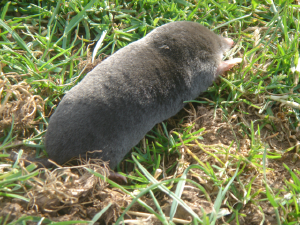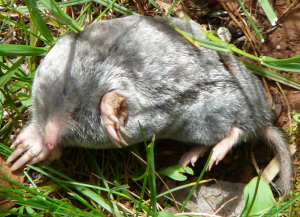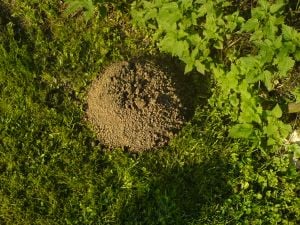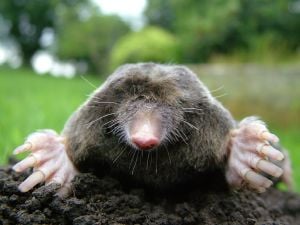Difference between revisions of "Mole (animal)" - New World Encyclopedia
Rick Swarts (talk | contribs) |
Rick Swarts (talk | contribs) |
||
| Line 16: | Line 16: | ||
17 genera, see text | 17 genera, see text | ||
}} | }} | ||
| − | In [[zoology]], a '''mole''' is the common name for any of the small insectivorous [[mammal]]s of the family '''Talpidae''' of the order [[Soricomorpha]] | + | In [[zoology]], a '''mole''' is the common name for any of the small insectivorous [[mammal]]s of the family '''Talpidae''' of the order [[Soricomorpha]]. Moles typically live underground, burrowing holes, but some species are semi-aquatic. Moles have small or vestigial eyes and ears. |
| + | The word mole is also used for members of the family Chrysochloridae, known as golden moles, and for small burrowng [[Australia]]n marsupials called marsupial moles. However, the "true moles" are exclusive to the Talpidae family and are the focus of this article. | ||
| + | ==Description== | ||
| + | True moles have thickset, cylindrical bodies, with a short neck, and are covered in [[fur]], which is typically light brown to dark gray or light black. Most are small, about 15 centimeters (6 inches) in length, with the smallest North American mole being the American shrew-mole (''Neurotrichus gibbsii''), which is about 10 centimeters (cm) in length, including a 3 cm long tail, and which weighs about 10 grams. Perhaps the largest mole is the Russian desman (''Desmana moschata''), which has a body that is 18 to 21 cm long and a 17 to 20 cm in length, and weight from 400 to 520 grams. | ||
| − | Male moles are called boars; females are called sows. A | + | Moles have small or rudimentary [[eye]]s covered in fur or skin and that have little visual acuity, but can detect light. Moles are functionally blind in this respect and obtain much of their sensory input from the touch sensitive Eimer's organs at the end of its long, bi-lobed snout. The ears are generally not visible, but moles have good hearing. |
| + | |||
| + | The forelimbs of moles are short, broad, powerful, and adapted for digging, having a body structure like a spade and with digging claws. | ||
| + | |||
| + | Moles tunnel below the ground, digging perhaps 15 to 20 meters in a single day. Most are good swimmers and some are semi-aquatic. For example, the star-nosed mole (''Condylura cristata''), found in eastern [[Canada]] and the [[Northeastern United States|north-eastern United States]], lives in wet lowland areas and can forage along the bottoms of streams and ponds. Like other moles, this animal digs shallow surface tunnels for foraging; often, these tunnels exit underwater. The Russian desman, ''Desmana moschata'', is a small semi-aquatic mole that inhabits the Volga, Don, and Ural River basins in [[Russia]], [[Ukraine]], and [[Kazakhstan]]. It constructs burrows into the banks of ponds and slow moving streams, but prefers small, overgrown ponds with abundance of insects and amphibians. The hind feet are webbed and the tail laterally flatened—specializations for its aquatic habitat. | ||
| + | |||
| + | Most species of mole tend to be solitary, but the Russian desman often lives in small (usually non-kin related) groups of 2 to 5 animals and appears to have a complex (but largely unstudied) communication and social system. The star-nosed mole also is speculated to be colonial. | ||
| + | |||
| + | Moles can be found in [[North America]], [[Europe]], and [[Asia]]. | ||
| + | |||
| + | Male moles are called boars; females are called sows. A group of moles is called a ''labour''. Since at least the era of [[Early Modern English]] the mole was also known in the [[United Kingdom]] as a "moldywarp" or "moldywarpes" (Rackham 2004). | ||
== Diet == | == Diet == | ||
| − | A mole's diet is primarily composed of earthworms and other small invertebrates. The mole will also occasionally catch small mice at the entrance to its burrow. Once the food is caught, the mole will either store it for later or feed it to its young. | + | Moles are insectivores: a carnivore with a diet that consists chiefly of small creatures like insects. A mole's diet is primarily composed of earthworms and other small invertebrates. The mole will also occasionally catch small mice at the entrance to its burrow. Once the food is caught, the mole will either store it for later or feed it to its young. The star-nosed mole feeds on small invertebrates, aquatic insects, worms, and molluscs. The Russian desman may feed on small [[amphibian]]s as well. |
| − | The | + | The star-nosed mole can detect, catch and eat food faster than the human eye can follow (under 300 milliseconds) (Salisbury 2005). |
| − | == | + | ==Pest status== |
| − | [[ | + | Moles are considered to be an [[agriculture|agricultural]] pest in some countries, while in others, such as [[Germany]], they are a protected species but may be killed if a permit is received. Problems cited as caused by moles include contamination of [[silage]] with soil particles making it unpalatable to animals, the covering of pasture with fresh soil reducing its size and yield, damage to agricultural machinery by the exposure of stones, damage to young plants through disturbance of the soil, weed invasion of pasture through exposure of fresh tilled soil, and damage to drainage systems and watercourses. Other species such as [[weasel]]s and [[vole]]s may use mole tunnels to gain access to enclosed areas or plant roots. |
| − | + | Moles that burrow in the lawns of humans can disturb the earth, raising [[molehill]]s and causing enough aesthetic problems, and killing enough of the lawn, to be considered as [[pest (animal)|pests]]. | |
| − | + | ||
| + | On the other hand, moles benefit soil by aerating and tilling it, adding to its fertility, and they consume animals themselves considered pests. Contrary to popular belief, moles don't eat plant roots. | ||
| + | |||
| + | They are controlled with traps and poisons such as [[calcium carbide]] and [[strychnine]]. | ||
| + | |||
| + | The [[castor plant]] is known as the "mole plant", because of its reputation as a mole-repelling [[companion plant]]. It contains several substances that are either toxic or just unpleasant and may emit some of these into the soil via its roots. One of its most well-known toxins is [[ricin]], in the news as an extract reputed to be attractive to terrorists as a poison. Castor oil, too, is advocated as a mole repellent. | ||
| + | |||
| + | Other common remedies for moles include cat litter and blood meal, to repel the mole, or flooding or smoking its burrow. There are also devices sold to trap the mole in its burrow, when one sees the "mole hill" moving and therefore knows where the animal is, and then stabbing it. Other, "humane" traps are used to capture the mole so that it may be transported elsewhere. | ||
==Classification== | ==Classification== | ||
| Line 68: | Line 88: | ||
* Subfamily [[Uropsilinae]] | * Subfamily [[Uropsilinae]] | ||
** Genus ''[[Uropsilus]]'' | ** Genus ''[[Uropsilus]]'' | ||
| − | |||
| − | |||
| − | |||
| − | |||
| − | |||
| − | |||
| − | |||
| − | |||
| − | |||
| − | |||
| − | |||
== Similarly named animals == | == Similarly named animals == | ||
| Line 124: | Line 133: | ||
==References== | ==References== | ||
{{reflist}} | {{reflist}} | ||
| + | |||
| + | <ref>[[Oliver Rackham|Rackham, Oliver]], ''The Illustrated History Of The Countryside'' page 130 (quoting J.Fitzherbert, ''The boke of surveying and improvments'' - [[sic]]) ISBN 0297843354</ref> (plural). The illustrated history of the countryside | ||
| + | by Oliver Rackham | ||
| + | Language: English Type: Book | ||
| + | Publisher: London : Weidenfeld & Nicolson, 2003 | ||
| + | |||
| + | 2-Feb-2005 | ||
| + | [ Print Article | E-mail Article | Close Window ] | ||
| + | Contact: David F. Salisbury | ||
| + | <ref>http://www.eurekalert.org/pub_releases/2005-02/vu-mmg013105.php Marsh-dwelling mole gives new meaning to the term 'fast food' | ||
| + | </ref> | ||
| + | |||
==External links== | ==External links== | ||
| Line 131: | Line 152: | ||
* [http://www.defra.gov.uk/wildlife-countryside/vertebrates/reports/mole-review.pdf UK Government DEFRA paper on control the European Mole] | * [http://www.defra.gov.uk/wildlife-countryside/vertebrates/reports/mole-review.pdf UK Government DEFRA paper on control the European Mole] | ||
| − | {{credit|Mole_(animal)|146391777|Golden_mole|148354672|Marsupial_mole|143473041}} | + | {{credit|Mole_(animal)|146391777|Golden_mole|148354672|Marsupial_mole|143473041|Star-nosed_Mole|149728918|Russian_Desman|133725497}} |
[[Category:Life sciences]] | [[Category:Life sciences]] | ||
Revision as of 21:56, 13 August 2007
| Moles[1] | ||||||||||
|---|---|---|---|---|---|---|---|---|---|---|
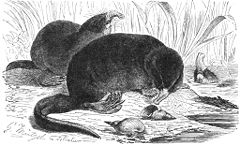 | ||||||||||
| Scientific classification | ||||||||||
| ||||||||||
|
17 genera, see text |
In zoology, a mole is the common name for any of the small insectivorous mammals of the family Talpidae of the order Soricomorpha. Moles typically live underground, burrowing holes, but some species are semi-aquatic. Moles have small or vestigial eyes and ears.
The word mole is also used for members of the family Chrysochloridae, known as golden moles, and for small burrowng Australian marsupials called marsupial moles. However, the "true moles" are exclusive to the Talpidae family and are the focus of this article.
Description
True moles have thickset, cylindrical bodies, with a short neck, and are covered in fur, which is typically light brown to dark gray or light black. Most are small, about 15 centimeters (6 inches) in length, with the smallest North American mole being the American shrew-mole (Neurotrichus gibbsii), which is about 10 centimeters (cm) in length, including a 3 cm long tail, and which weighs about 10 grams. Perhaps the largest mole is the Russian desman (Desmana moschata), which has a body that is 18 to 21 cm long and a 17 to 20 cm in length, and weight from 400 to 520 grams.
Moles have small or rudimentary eyes covered in fur or skin and that have little visual acuity, but can detect light. Moles are functionally blind in this respect and obtain much of their sensory input from the touch sensitive Eimer's organs at the end of its long, bi-lobed snout. The ears are generally not visible, but moles have good hearing.
The forelimbs of moles are short, broad, powerful, and adapted for digging, having a body structure like a spade and with digging claws.
Moles tunnel below the ground, digging perhaps 15 to 20 meters in a single day. Most are good swimmers and some are semi-aquatic. For example, the star-nosed mole (Condylura cristata), found in eastern Canada and the north-eastern United States, lives in wet lowland areas and can forage along the bottoms of streams and ponds. Like other moles, this animal digs shallow surface tunnels for foraging; often, these tunnels exit underwater. The Russian desman, Desmana moschata, is a small semi-aquatic mole that inhabits the Volga, Don, and Ural River basins in Russia, Ukraine, and Kazakhstan. It constructs burrows into the banks of ponds and slow moving streams, but prefers small, overgrown ponds with abundance of insects and amphibians. The hind feet are webbed and the tail laterally flatened—specializations for its aquatic habitat.
Most species of mole tend to be solitary, but the Russian desman often lives in small (usually non-kin related) groups of 2 to 5 animals and appears to have a complex (but largely unstudied) communication and social system. The star-nosed mole also is speculated to be colonial.
Moles can be found in North America, Europe, and Asia.
Male moles are called boars; females are called sows. A group of moles is called a labour. Since at least the era of Early Modern English the mole was also known in the United Kingdom as a "moldywarp" or "moldywarpes" (Rackham 2004).
Diet
Moles are insectivores: a carnivore with a diet that consists chiefly of small creatures like insects. A mole's diet is primarily composed of earthworms and other small invertebrates. The mole will also occasionally catch small mice at the entrance to its burrow. Once the food is caught, the mole will either store it for later or feed it to its young. The star-nosed mole feeds on small invertebrates, aquatic insects, worms, and molluscs. The Russian desman may feed on small amphibians as well.
The star-nosed mole can detect, catch and eat food faster than the human eye can follow (under 300 milliseconds) (Salisbury 2005).
Pest status
Moles are considered to be an agricultural pest in some countries, while in others, such as Germany, they are a protected species but may be killed if a permit is received. Problems cited as caused by moles include contamination of silage with soil particles making it unpalatable to animals, the covering of pasture with fresh soil reducing its size and yield, damage to agricultural machinery by the exposure of stones, damage to young plants through disturbance of the soil, weed invasion of pasture through exposure of fresh tilled soil, and damage to drainage systems and watercourses. Other species such as weasels and voles may use mole tunnels to gain access to enclosed areas or plant roots.
Moles that burrow in the lawns of humans can disturb the earth, raising molehills and causing enough aesthetic problems, and killing enough of the lawn, to be considered as pests.
On the other hand, moles benefit soil by aerating and tilling it, adding to its fertility, and they consume animals themselves considered pests. Contrary to popular belief, moles don't eat plant roots.
They are controlled with traps and poisons such as calcium carbide and strychnine.
The castor plant is known as the "mole plant", because of its reputation as a mole-repelling companion plant. It contains several substances that are either toxic or just unpleasant and may emit some of these into the soil via its roots. One of its most well-known toxins is ricin, in the news as an extract reputed to be attractive to terrorists as a poison. Castor oil, too, is advocated as a mole repellent.
Other common remedies for moles include cat litter and blood meal, to repel the mole, or flooding or smoking its burrow. There are also devices sold to trap the mole in its burrow, when one sees the "mole hill" moving and therefore knows where the animal is, and then stabbing it. Other, "humane" traps are used to capture the mole so that it may be transported elsewhere.
Classification
The family is divided into 3 subfamilies, 7 tribes, and 17 genera:
- Subfamily Scalopinae
- Tribe Condylurini
- Genus Condylura
- Tribe Scalopini
- Genus Parascalops
- Genus Scalopus
- Genus Scapanulus
- Genus Scapanus
- Tribe Condylurini
- Subfamily Talpinae
- Tribe Desmanini
- Genus Desmana
- Genus Galemys
- Tribe Neurotrichini
- Genus Neurotrichus
- Tribe Scaptonychini
- Genus Scaptonyx
- Tribe Talpini
- Genus Euroscaptor
- Genus Mogera
- Genus Parascaptor
- Genus Scaptochirus
- Genus Talpa
- Tribe Urotrichini
- Genus Dymecodon
- Genus Urotrichus
- Tribe Desmanini
- Subfamily Uropsilinae
- Genus Uropsilus
Similarly named animals
Other similar animals are found in family Chrysochloridae (the golden moles) and family Notoryctidae (the marsupial moles) which are not related to true moles.
There are also similar-looking but herbivorous rodents called mole-rats that lead a similar life and are commonly called "moles", although, unlike mole-rats, no species of true mole is known to be eusocial.
Golden moles
Golden moles are small, insectivorous burrowing mammals native to southern Africa. They belong to the family Chrysochloridae, and so are taxonomically distinct from the true moles. The golden moles bear a remarkable resemblance to the marsupial moles of Australia, so much so that, the marsupial/placental divide notwithstanding, they were once thought to be related.
Golden moles live almost exclusively underground. Like several other burrowing mammals with similar habits, have short legs with powerful digging claws, very dense fur that repels dirt and moisture, and toughened skin, particularly on the head. They retain eyes but they are non-functional and covered with skin and fur, the ears are just tiny openings, and, like the marsupial moles, they have an enlarged leather-like pad to protect their nostrils.
They range in size from about 8 to about 20 cm. They have muscular shoulders and an enlarged third claw to aid digging on the forelimbs, with no fifth digit and vestigal first and fourth; the hind feet retain all five toes and are webbed to allow efficient backward shoveling of the soil loosened with the front claws.It feeds off small insects , which it triangulises by using its tiny ears to listen to the sound of the long grass in the wind (its ears are natural geophones).
Because these mammals were previously thought to have originated in Gondwana, golden moles used to be regarded as rather 'primitive' creatures: their low resting metabolic rate and their ability to switch off thermoregulation when inactive, however, are no longer regarded as indications that golden moles are undeveloped 'reptilian mammals', but rather as essential adaptations to a harsh climate. By going into a torpor when resting or during cold weather, they conserve energy and reduce their need for food. Similarly, they have developed particularly efficient kidneys and most species do not need to drink water at all.
Of the 21 species of golden mole, no less than 11 are threatened with extinction. The primary causes are sand mining, poor agricultural practices, increasing urbanisation, and predation by domestic cats and dogs.
As with many groups, the classification of the golden moles is undergoing an upheaval at present in the light of the flood of new genetic information becoming available. They have traditionally been listed with the shrews, hedgehogs and a grab-bag of small, difficult-to-place creatures as part of the order Insectivora. Some authorities retain this classification, at least for the time being. Others group the golden moles with the tenrecs in a new order which is sometimes known as Tenrecomorpha, while others call it Afrosoricida and reserve Tenrecomorpha for the Tenrecidae family.
Marsupial moles
The marsupial moles are rare and poorly understood burrowing mammals of the deserts of western Australia.
Marsupial moles spend most of their time underground, coming to the surface only occasionally, probably mostly after rains. They are blind, their eyes having become reduced to vestigial lenses under the skin, and they have no external ears, just a pair of tiny holes hidden under thick hair.
The head is cone-shaped, with a leathery shield over the muzzle, the body tubular, the tail a short, bald stub. They are between 12 and 16 cm long, weigh 40 to 60 grams, and are uniformly covered in fairly short, very fine pale cream to white hair with an iridescent golden sheen. Their pouch has evolved to face backwards so that it does not fill with sand.
Marsupial moles provide a remarkable example of convergent evolution, with moles generally, and with the golden moles of Africa in particular. Although only related to other moles in that all are mammals, the external similarity is an extraordinary reflection of the similar evolutionary paths they have followed.
For many years their place within the Marsupials was hotly debated, some workers regarding it as an offshoot of the Diprotodontia (the order to which most living marsupials belong), others noting similarities to a variety of other creatures, and making suggestions that, in hindsight, appear bizarre. A 1989 review of the early literature, slightly paraphrased, states:
- When Stirling (1888) initially was unable to find the epipubic bones in Marsupial Moles, speculation was rife: the Marsupial Mole was a monotreme, it was the link between monotremes and marsupials, it had it closest affinities with the (placental) golden moles, it was convergent with edentates, it was a polyprotodont diprotodont, and so on. [1]
The mystery was not helped by the complete silence of the fossil record. On the basis that marsupial moles have some characteristics in common with almost all other marsupials, they were eventually classified as an entirely separate order: the Notoryctemorphia. Molecular level analysis in the early 1980s showed that the marsupial moles are not closely related to any of the living marsupials, and that they appear to have followed a separate line of development for a very long time, at least 50 million years. However some morphological evidence suggests that they may be related to bandicoots.
In 1985, the vast newly discovered limestone fossil deposits at Riversleigh in northern Queensland yielded a major surprise: a fossil between 15 and 20 million years old named Yalkaparidon coheni with molars like a marsupial mole, diprotodont-like incisors, and a skull base similar to that of the bandicoots. These features were by no means identical to the living species but clearly related, and possibly even of a direct ancestor. In itself, the discovery of a Miocene marsupial mole presented no great mysteries. Just like the modern forms, it had many of the features that are assumed to be adaptations for a life burrowing in desert sands, in particular the powerful, spadelike forelimbs. The Riversleigh fossil deposits, however, are from an environment that was not remotely desert-like: in the Miocene, the Riversleigh area was a tropical rainforest.
One suggestion advanced was that the Miocene marsupial mole used its limbs for swimming rather than burrowing, but the mainstream view is that it probably specialised in burrowing through a thick layer of moss, roots, and fallen leaf litter on the rainforest floor, and thus, when the continent began its long, slow desertification, the marsupial moles were already equipped with the basic tools that they now use to burrow in the sand dunes of the Western Australian desert.
There are thought to be two species: the Southern Marsupial Mole (Notoryctes typhlops or itjaritjari as known by the Pitjantjatjara and Yankunytjatjara people in Central Australia [2], and the Northern Marsupial Mole (Notoryctes caurinus), so similar to one another that they cannot be reliably told apart in the field.
The marsupial mole, once classified as a monotreme, is now known to be a marsupial. Its ancestry goes back 50 million years or more, and its precise classification is still a matter for argument.
ReferencesISBN links support NWE through referral fees
- ↑ Hutterer, Rainer (2005-11-16). in Wilson, D. E., and Reeder, D. M. (eds): Mammal Species of the World, 3rd edition, Johns Hopkins University Press, 300-311. ISBN 0-801-88221-4.
- ↑ Accessed on 9 November 2006 http://www.marsupialsociety.org/members/mole_patrol.html
[1] (plural). The illustrated history of the countryside by Oliver Rackham Language: English Type: Book Publisher: London : Weidenfeld & Nicolson, 2003
2-Feb-2005 [ Print Article | E-mail Article | Close Window ] Contact: David F. Salisbury [2]
External links
Credits
New World Encyclopedia writers and editors rewrote and completed the Wikipedia article in accordance with New World Encyclopedia standards. This article abides by terms of the Creative Commons CC-by-sa 3.0 License (CC-by-sa), which may be used and disseminated with proper attribution. Credit is due under the terms of this license that can reference both the New World Encyclopedia contributors and the selfless volunteer contributors of the Wikimedia Foundation. To cite this article click here for a list of acceptable citing formats.The history of earlier contributions by wikipedians is accessible to researchers here:
- Mole_(animal) history
- Golden_mole history
- Marsupial_mole history
- Star-nosed_Mole history
- Russian_Desman history
The history of this article since it was imported to New World Encyclopedia:
Note: Some restrictions may apply to use of individual images which are separately licensed.
- ↑ Rackham, Oliver, The Illustrated History Of The Countryside page 130 (quoting J.Fitzherbert, The boke of surveying and improvments - sic) ISBN 0297843354
- ↑ http://www.eurekalert.org/pub_releases/2005-02/vu-mmg013105.php Marsh-dwelling mole gives new meaning to the term 'fast food'
